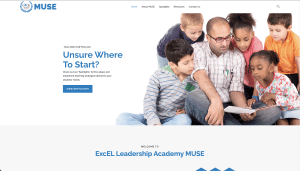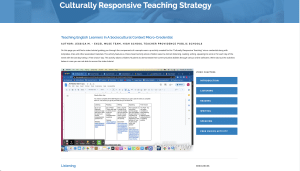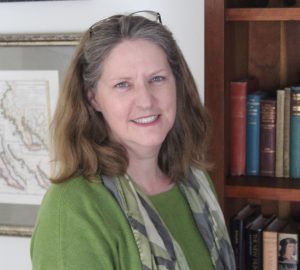MUltilingual Strategies for Educators (Project MUSE): Extending the Reach of Teacher Mastery with the ExcEL Leadership Academy
CompetencyWorks Blog
In this post, UCLA researchers describe a new resource – MUltilingual Strategies for Educators (MUSE). MUSE is a platform that grants all teachers of multilingual learner (MLL) students access to curated Spotlights, or worked examples, derived from UCLA’s ExcEL Leadership Academy teachers’ submissions of their micro-credential or Essential Competency Area portfolios to the ExcEL program. This post is one of a series that highlights different experiences with the ExcEL MLL micro-credential program featured in the Aurora Institute report: ExcEL Leadership Academy Micro-Credential Pathway Adoption in Rhode Island.
What Is MUSE and How Does It Fit Within the ExcEL Program?
MUltilingual Strategies for Educators (Project MUSE) is a newly developed teacher-to-teacher platform sharing standards-aligned classroom strategies that support MLL student development. The platform was created by participating ExcEL Leadership Academy teachers and UCLA ExcEL researchers, with the purpose of sharing the work of ExcEL educators, and reflecting on what worked in their own classrooms. The site intends to share widely strategies for teaching MLL students, which contributors submitted as part of the competency portfolios developed in the ExcEL program.
The platform hosts Spotlights in which teachers provide detailed walk-throughs of their strategies for working with MLL students. Spotlights currently correspond to the six Essential Competency Areas recommended for all teachers who are teaching MLL students. Educators can dive into key learnings in areas such as implementing effective instructional strategies for students at different stages of language acquisition, and promoting developmentally, culturally and linguistically appropriate assessment of MLL students to equitably monitor their content and language learning. Examples of student work accompany the Spotlight strategies along with direct links to resources ExcEL teachers have personally drawn on and found to be successful in supporting MLL students.
The objective is to make the Project MUSE website a standalone resource for professional learning centered on innovative instruction and assessment strategies for PK-12 MLL students. 
Learning Suited to Adults
The choice of the acronym MUSE is intentional – the platform is meant to be a source of inspiration to augment the practices of other teachers. It also serves as a guide, crafted by teachers who have garnered experience and new knowledge, to facilitate the learning of those still learning how to teach MLL students effectively. As adult learners, however, teachers may learn differently from the children they teach. While not true of all adults, more mature learners may be better aware of what they do and do not know. They may be able to successfully direct their learning behaviors without an instructor to help them address key gaps in their teaching knowledge and skills. The intrinsic motivation to learn more, the opportunities to put that knowledge to immediate use, and to integrate new learning to help problem-solve or improve daily practices all characterize andragogy – the area of education that seeks to understand adult learning and the facets of workplace education (endnote 1). These intentional actions on the part of teachers to promote their own learning are at the heart of the ExcEL program pursued by teachers of MLL students.
Much like the Aurora Institute’s own focus on promoting competency-based, personalized learning for PK-12 students, ExcEL professional learning adopts an approach that takes the learner away from traditional “seat-time” approaches to learning, such as time-bound college courses. It allows teachers to become the autonomous drivers of their own learning through demonstrating their mastery of target skills personalized to their own learning styles and pace. Teachers choose an area of their practice to reflect and improve upon with the MLL students they currently are teaching. With MUSE, all educators now have a resource to pick and choose what, when, and where to learn more about instruction for MLL students.
 Teachers Leading Teachers
Teachers Leading Teachers
Although the MLL student population is steadily growing, adapting instruction to individual MLL students may still be a new experience for many teachers. This may be especially so in regions of the country that have recently seen larger increases in the numbers of students who are learning English (endnote 2). MUSE leverages the experience of teachers who have developed expertise in the Essential Competency Areas and offers their insights to those who may be welcoming MLLs in the classroom for the first time. This form of teacher collaboration is a well-established avenue of professional development for pre-service and in-service educators alike (endnote 3). By adopting a teachers-leading-teachers approach, the MUSE platform serves two distinct functions: 1) it gives a wider range of educators access to the work of a community of practice, and 2) it further develops the expertise of the contributing ExcEL teachers.
MUSE was developed through a community of practice (CoP) approach (endnote 4). The MUSE team of educators and researchers were united by their shared goal of delivering equitable education to all students, and came together to learn more about MLL teaching strategies, exchange quality resources, and provide feedback to each other as they generated Spotlights for the platform. 
The MUSE team understands that despite educators’ desire to improve their pedagogy, opportunities to do so are limited. The curated Spotlights intend to expose educators to the potential benefits of peer-supported learning. ExcEL teachers serve as exemplary members of local teaching communities who have adapted creative responses to the dynamics present in their classrooms. Their contextualized, competency-based teaching strategies serve as models for the possibilities of equitable education developed out of in-service experience. MUSE demonstrates the power of educators who possess the disposition to reflect critically on the needs of their classrooms.
The collaborative CoP process that led to the creation of MUSE also offers teachers on the MUSE team further development of their own professional skills. The platform is in effect a virtual landscape in which more expert teachers can guide the progression of those new to teaching MLL students. By contributing to MUSE, ExcEL teachers have been able to reflect on their pedagogy beyond the implementation stage and further refine their capacity to deliver quality instruction. They also progress their involvement in MLL education along a continuum of professionalism to provide leadership and new learning opportunities to peers (endnote 5).
MUSE joins the virtual learning ecosystem to help restructure traditional professional learning environments. An example of the typical hierarchical structure of professional learning is the oft-lamented situation of professional development that “is done to or for teachers, rather than by or with them” (endnote 6). In contrast, MUSE is based on a democratic, by-teachers-for-teachers foundation.
Leveraging What We Know about Adult Learning
The adult learning literature identifies several key characteristics (endnote 7) that are built into the design and intended uses of MUSE.
- Teachers, as adult learners, have most likely developed an independent self-concept by the point in their lives when they are educators, which means their learning may more successfully be self-directed. They know best what they need to learn about MLL student instruction. To be effective, teacher-learning choices will still need to be intentional or “systematic yet [their learning] does not depend on an instructor or a classroom” (endnote 8). The content of the MUSE platform is accessed whenever teachers have the time or interest, so it is available 24/7. Additionally, the content is tagged for student language proficiency level, grade range, language modality, etc., thus providing teachers with the autonomy needed to most effectively plan and personalize their learning.
- Teachers, including pre-service teachers, have many years of experience with formal education – their own as well as from the classrooms in which they work. These prior experiences can provide teachers with rich sources to further their own learning. MUSE invited and continues to invite contributions from experienced teachers who are participating in the ExcEL program. Jessica Mazo, a member of the MUSE CoP and Spotlight author, writes in her CompetencyWorks blog post, that “I was able to tap into my own abilities and my background knowledge, as well as use my current teaching experience to complete the program.” And she brings this knowledge and her personal experiences with working with MLL students to the strategies she has shared on MUSE.
- Teachers who visit the MUSE site will undoubtedly do so because they have new learning needs related to their changing social roles as educators of MLL students. The open access to teaching strategies and resources illustrated in the Spotlights can make the transformation of roles a more obtainable one for teachers everywhere.
- Adult learners in the workplace focus on the knowledge and skills they need to know. Their learning is frequently problem-centered and intended for immediate use. The Spotlights of MLL instructional strategies are organized by the competency-based modules. Teachers can therefore readily select which areas of growth, interest, and impact are currently most relevant to them and their students’ needs.
- If sufficiently motivated, adult learners will be ready to learn and oriented towards acquiring new, sometimes challenging, skills and knowledge. MUSE was built to cater to the teacher-user: a teacher seeking outside information to assist them with becoming a more effective teacher of MLL students. Seeking out knowledge comes from an internal desire to better serve all students. Readiness is leveraged by encouraging teachers to adapt Spotlights to the pressing needs found in their own classroom contexts, and promoting an open mind (a positive learning orientation) is supported by providing teachers with the chance to try out strategies that may previously have been unknown to them.
“So I think what we are hoping to create is just having a place where there are resources and examples and work that has already been done. This would be so helpful because someone who’s starting from scratch is indeed just starting from scratch kind of, without having that background. This could be an inspirational starting point for them.” – Kelly Kerwin, Third Grade Teacher
“This free resource has the potential to be a catalyst for truly changing instruction across classrooms all in the name of providing equitable learning opportunities for our bilingual and multilingual children. When it comes to teacher preparation programs and professional development, I think that this type of professional resource is exactly what we as teachers benefit most from— learning from each other. Just like how our teaching goes beyond the four walls of our classroom, this online resource allows for our professional learning to not be confined to our school, our district or even our state.” – Jessica Baldizon, MLL Teacher for Third-Fifth Grades
Where Do We Go From Here?
Moving into year two of MUSE development, we are continuing to add more functionality (new search options) and more Spotlights, including those adapted from teacher portfolios for the six Advanced Competency Areas recommended for ESL specialists. We would like to extend an invitation to share your experiences on the MUSE platform. Please fill out our contact form if you are interested in providing feedback on your use of MUSE to contribute to the platform’s improvement.
It is our hope that MUSE users also take advantage of the opportunity to connect with Spotlight authors and begin to develop their own learning networks. With several features meant to enhance personalized learning, teacher autonomy is always centered in the user experience of MUSE.
Learn More
- Webinar: Educator Micro-Credential Pathway Adoption in Rhode Island
- Rethinking Learning Through Educator Micro-Credentials
- Educator Micro-Credentials: Better for My Learning and Better for Students
- Empowering ELL Students and Myself: One New Hampshire Teacher’s Micro-Credential Experience
- Learning Through Micro-Credentials Enables Student-Centered Teaching Philosophy
 Alison L. Bailey is Professor and Division Head of Human Development and Psychology in the Department of Education, University of California, Los Angeles. She is a developmental psycholinguist with expertise developing language learning progressions with multilingual learners, and supporting teachers’ language pedagogy and assessment practices. She is the co-author of Progressing Students’ Language Day by Day (2019, Corwin Press), and currently the PI of the U.S. Department of Education National Professional Development grants supporting the ExcEL Leadership Academy.
Alison L. Bailey is Professor and Division Head of Human Development and Psychology in the Department of Education, University of California, Los Angeles. She is a developmental psycholinguist with expertise developing language learning progressions with multilingual learners, and supporting teachers’ language pedagogy and assessment practices. She is the co-author of Progressing Students’ Language Day by Day (2019, Corwin Press), and currently the PI of the U.S. Department of Education National Professional Development grants supporting the ExcEL Leadership Academy.

Edwin Zamora is a third year doctoral student in the Human Development and Psychology program at the University of California, Los Angeles. His interest in the language and literacy outcomes of multilingual children stems from his experience as a sequential bilingual (L1: Spanish, L2: English) who went through California’s ELD programming during his early schooling. He is currently conducting an assets-based study on the learning behaviors of Spanish-English dual language learners in the database of the U.S. Department of Education’s Early Childhood Longitudinal Study (ECLS-K: 2011).
Contact the MUSE team using this form.
Endnote References
1 – Knowles, M. S., Holton III, E. F., & Swanson, R. A. (2015, 8th Edition). The Adult Learner: The Definitive Classic in Adult Education and Human Resource Development. Routledge; Knowles, M. (1984). Andragogy in Action. San Francisco: Jossey-Bass; Knowles, M. (2013). Andragogy: An emerging technology for adult learning. In R. Edwards, R., A. Hanson, & P. Raggatt, (Eds.). Boundaries of Adult Learning (pp. 82-98). Routledge; Merriam, S. B. (2001). Andragogy and self-directed learning: Pillars of adult learning theory. New Directions for Adult and Continuing Education, 89, 3-13; Merriam, S. B., & Bierema, L. L. (2013). Adult Learning: Linking Theory and Practice. John Wiley & Sons.
2 – Najarro, I. (June 19, 2024). The English-Learner Student Population, in Charts. Education Week. https://www.edweek.org/teaching-learning/the-english-learner-student-population-in-charts/2024/06.
3 – Walker, C., & Edstam, T. S. (2013). Staff development while you teach: Collaborating to serve English Learners. TESOL Journal, 4(2), 345–359. https://doi.org/10.1002/tesj.81.
4 – Wenger, E. (2008). Communities of Practice: A Brief Introduction. https://scholarsbank.uoregon.edu/xmlui/bitstream/handle/1794/11736/A%20brief%20introduction%20to%20CoP.pdf?sequence=1.
5 – Cerda, J., & Bailey, A. L. (2019, Oct.). Evidence of proficiency in professional learning: Designing expertise progressions. Report to ELPA21 Consortium. Los Angeles, CA: National Center for Research on Evaluation, Standards, and Student Testing.
6 – McCotter, S. (2001, p.701). Collaborative groups as professional development. Teaching and Teacher Education, 17(6), 685–704; Neuhard, J., (2023). Micro-credentialing and Digital Badging as A Form of Professional Learning for Educational Specialists: A Phenomenological Study. https://www.proquest.com/docview/2912160753?pq-origsite=primo&parentSessionId=k2tIi0DLgDyLdqPSbE9SMfcVB%2FFqIlPhahN7ugfOnq0%3D.
7 – Knowles, et al. (2015, 8th Edition, pp.4-5); Merriam (2001, p.5); Merriam, S. B., & Clark, M. C. (2006). Learning and development: The connection in adulthood. In C. Hoare (Ed.). Handbook of Adult Development and Learning (pp.27- 51). Oxford University Press.
8 – Merriam (2001, p.8).